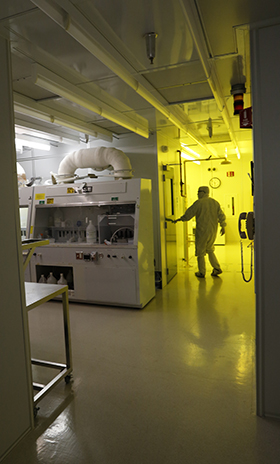
The University of New Mexico Center for High Tech Materials (CHTM) is dedicated to excellence in photonics, microelectronics and nanoscale materials and devices and their applications.

Thanks to the Air Force Research Laboratory, home of the Air Force’s Directed Energy Directorate, New Mexico is THE HUB of directed energy and photonics research. With companies like OptiPulse, SolAero, and Skorpios, New Mexico leads in technology development in lasers systems, high power electromagnetics weapons modeling and simulation, space solar cells, and directed energy and electro-optics.
New Mexico has a rich environment for technology commercialization via 3 national laboratories, 3 renowned research universities, and many nonprofit research institutions. Most of these institutions offer specialized services and facilities to entrepreneurs and businesses.
Los Alamos National Laboratory (LANL) was established in 1943 as site Y of the Manhattan Project for the single purpose of building an atomic bomb. The lab’s mission continues to be national security with a focus on nuclear proliferation, border security, energy and infrastructure security, and countermeasures to nuclear and biological terrorist threats. In addition, the lab works to assure the safety, security, and reliability of the nation’s nuclear deterrent.
LANL’s fundamental science activities include: high-energy and applied physics and theory, high-performance computing, dynamic and energetic materials science, superconductivity, quantum information, advanced materials, bioinformatics, theoretical and computational biology, chemistry, earth and environmental science, alternative energy systems, and engineering sciences and applications.
Partnering or licensing a technology is offered at LANL through the Richard P. Feynman Center for Innovation.
Sandia National Laboratories (SNL) has also had a presence in New Mexico since the 1940’s. The lab collaborates with other government agencies, industry, and academic institutions on its fourfold mission which is composed of nuclear weapons, defense systems and assessments, energy and climate, international, homeland, and nuclear security. Sandia’s core capabilities reside in 4 broad areas: systems engineering and integration, high-performance computing and modeling and simulation, extreme-environment testing at unique facilities, and nanotechnologies and microsystems.
Research conducted at SNL is founded in 7 areas: bioscience, computing and information science, engineering science, geoscience, materials science, nanodevices and microsystems, and radiation effects and high energy density science. Within each area, Sandia works with academic and business leaders to support essential activities that translate into invention, innovation, entrepreneurship, economic opportunity, and public benefit. Toward this end, SNL also operates 22 Technology Deployment Centers.
The Air Force Research Laboratory (AFRL) at Kirtland Air Force Base in Albuquerque operates 2 of the Air Force’s 7 technical directorates: Directed Energy and Space Vehicles. The Directed Energy Directorate is the Air Force’s center of expertise for directed energy and optical technologies, with a focus in 4 core technical competencies: laser systems, high power electromagnetics, weapons modeling and simulation, and directed energy and electro-optics for space superiority. The Space Vehicles Directorate is comprised of 3 distinct divisions: battlespace environment, spacecraft technology, and integrated experiments and evaluation.
AFRL has been recognized for many achievements including: scientist Dr. Candace Lynch receiving the Harold Brown Award for Pioneering Laser Materials Research, and Dr. Mark Draper, senior research engineering psychologist, received the Harry G. Armstrong Scientific Excellence Award for his scientific innovations that are revolutionizing Remotely Piloted Aircraft supervisory control interfaces.
The University of New Mexico (UNM) conducts research in many diverse fields. Research Centers and Institutes at the main and branch campuses include the Health Sciences Center, ARTS Lab, Institute for Astrophysics, New Mexico Center for Particle Physics, Center for High Technology Materials, Center for Micro-Engineered Materials, and the Center for Advanced Research Computing. Intellectual property and technology transfer is facilitated by UNM Rainforest Innovations.
New Mexico State University (NMSU) has demonstrated research capacity and contributions in 9 areas: Animal and Range Science, Biochemistry, Molecular Biology and Genetics, Computer Science and Computer and Electrical Engineering, Energy and Biofuels, Environment and Ecology, Medical and Health Sciences, Plant and Soil Sciences, and Space and Water. Intellectual property and technology transfer is facilitated by the Office of Intellectual Property and Technology Office at Arrowhead Center.
New Mexico Tech (NMT) is also a nationally-recognized research university. Research organizations at NMT include: Energetic Materials Research and Testing Center; Institute for Complex Additive Systems Analysis; Institute for Engineering Research and Applications, Magdalena Ridge Observatory, MicroElectronics Testing and Technology Obsolescence Program, Optical Surface Technologies, Petroleum Recovery Research Center, and the Research and Support Center for Applied Mathematical Modeling. New Mexico Tech has an Office of Innovation Commercialization
Arrowhead Center at NMSU brings researchers and entrepreneurs together to solve market problems and maximize market opportunities. This is done by commercializing the technology discovered by researchers and helping entrepreneurs navigate the market to monetize these new solutions. Industry sectors and government agencies are also served through the Arrowhead Park and Policy and Economic Impact Studies. Other services provided by the Arrowhead Center include: K – University Student Entrepreneurship, Business Creation & Growth, and Regional Economic Development Collaboratives
Arrowhead Accelerator Sprints assists startups in building a strong team and giving them access to tools and resources necessary for transforming ideas into businesses. Workshops, networking events, mentoring, assistance with capital sourcing and customer acquisition, and work-ready space are also available to incubator residents and friends. ATI specializes in startups emerging in the following industries: power, water, technology, Internet technology, and agri-tech.
The Center for Integrated Technologies (CINT) is jointly operated by Los Alamos and Sandia National Laboratories as a national user facility devoted to establishing the scientific principles that govern the design, performance, and integration of nanoscale materials. The Core Facility is located at Sandia and the Gateway Facility is located at Los Alamos. CINT focuses on 4 scientific areas: nanophotonics and optical nanomaterials; nanoscale electronics and mechanics; soft, biological, and composite nanomaterials; and theory and simulation of nanoscale phenomena.
The Center for Leadership in Technology Commercialization (CLTC) at NMT is located within the Department of Management and was created to spur entrepreneurial endeavors out of the university. CLTC offers students the opportunity to gain practical technology commercialization experience, and serves as a catalyst for quick development of licensing and intellectual property sharing opportunities. Examples of recent projects by students include: anti-bacterial agents, network monitoring, and novel refrigeration.
The New Mexico Consortium (NMC) was established to strengthen research that is in national interest and increase the role of Los Alamos National Laboratory (LANL) in science, education, and regional economic development. A nonprofit formed by the 3 New Mexico research universities, NMC promotes collaboration among academia, industry, and research. NMC’s science initiatives include: plant biology, biomedical technology and engineering, advanced computing, and modeling and analysis. NMC takes pride in the following core capabilities: PRObE, a supercomputing facility (funded by the National Science Foundation); the ability to perform cross-disciplinary research capable of fully characterizing cell function; and a biological laboratory equipped with wet laboratory facilities, specialized laboratories, a Photobioreactor Matrix, and a 4,000 square foot research greenhouse.
The New Mexico Manufacturing Extension Partnership (NM MEP), is an assistance center that works toward increasing small and mid-sized companies’ competitiveness. MEP’s expertise lies in many areas including: results-driven methodologies, best practices, and innovative technologies designed to increase profitability.
The New Mexico Small Business Assistance (NMSBA) Program offers technical assistance to New Mexico small businesses. Businesses with a technical challenge that require special expertise can seek assistance from scientists or engineers at Los Alamos and Sandia National Laboratories. Such projects include testing, design consultation, and access to special equipment or facilities.
The Small Business Innovation Research (SBIR) program urges small businesses to participate in Federal Research/Research and Development (R/R&D) with the objective of commercialization. The program is competitive and requires an application, which can be awarded a monetary prize for the purpose of conducting the research outlined in the application.
Rainforest Innovations, formerly STC.UNM, is the technology transfer office created by and for UNM. It is centrally located in proximity to research and development and laboratory facilities and other technology based companies, many of which are the result of Rainforest Innovations. It also collaborates with researchers at Sandia National Laboratories and Los Alamos National Laboratory.
Activities of the office include: protecting technologies developed at UNM and transferring them to the marketplace (either through the starting of new companies or transferring technologies to established companies); connecting the business community to UNM for access to expertise, facilities, and research activities; and facilitating UNM’s role as a contributor to New Mexico’s economic development.
New Mexico Economic
Development Department
Joseph M. Montoya Building
1100 S. St. Francis Drive
Santa Fe, NM 87505-4147
Mailing Address:
New Mexico Economic
Development Department
P.O. Box 20003
Santa Fe, NM 87504-5003
Main number: (505) 827-0300 (se habla español)
The mission of the New Mexico Economic Development Department is to Improve the lives of New Mexico families by increasing economic opportunities and providing a place for businesses to thrive.
Translate this site: